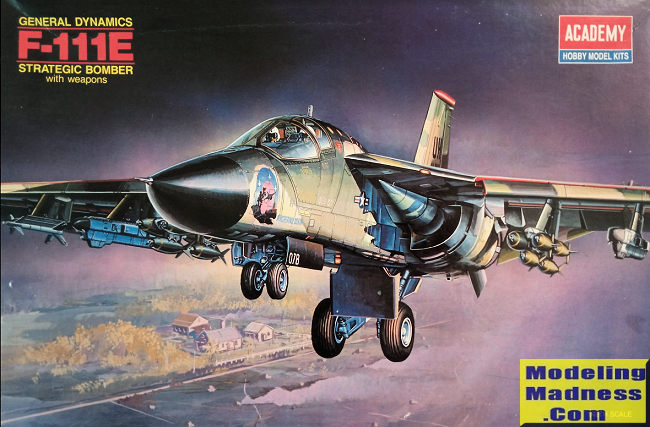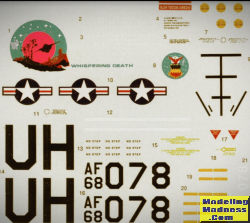
Academy 1/48 F-111E
| KIT #: | 1689 |
| PRICE: | $50.00 when new |
| DECALS: | One option |
| REVIEWER: | Spiros Pendedekas |
| NOTES: |

| HISTORY |
The General Dynamics F-111 is a retired supersonic, medium-range, multirole combat aircraft, with roles including interdiction, strategic bombing, reconnaissance and electronic warfare. It entered service in 1967 with the USAF and in 1973 with the RAAF, the only other user of the type. The plane proved operationally effective, being extensively used in the Vietnam War and in Operation Desert Storm. It was also used during the famous Operation El Dorado Canyon, conducting air strikes against Libya from too far away. USAF retired the type quite quickly (1996 and 1998 for the attack and electronic warfare versions respectively) due to high maintenance costs, while RAAF retired its fleet by 2010. In total, 563 examples were built.
| THE KIT |
 The
first 1/48 F-111 was done by Aurora as early as 1966, offered in TFX-A (Air
Force) and -B (Navy) versions respectively. The -A version with some new
parts (the revised Triple Plow intakes, among others) was reboxed by Monogram in
1981 and 1985. Academy came in 1987 with their “new tool” F-111, featuring,
among others, recessed panel lines. These kits were reboxed a remarkable 24
times (including twice by Hobbycraft and once by Italeri) till 2011, covering
all versions, let alone another 10 times issued/copied by Zhengdefu/Kitech.
The
first 1/48 F-111 was done by Aurora as early as 1966, offered in TFX-A (Air
Force) and -B (Navy) versions respectively. The -A version with some new
parts (the revised Triple Plow intakes, among others) was reboxed by Monogram in
1981 and 1985. Academy came in 1987 with their “new tool” F-111, featuring,
among others, recessed panel lines. These kits were reboxed a remarkable 24
times (including twice by Hobbycraft and once by Italeri) till 2011, covering
all versions, let alone another 10 times issued/copied by Zhengdefu/Kitech.
The specific kit is the1997 -E version, bought in 2004
from my then usual Athens hobby shop at a not exactly low price. The kit came in
a big, sturdy top opening box, carrying an attractive box art of a 20 TFW
machine taking off from (presumably) Upper Heyford, UK in 1991.
Upon opening the box, I was greeted with 126 light gray styrene parts arranged
in 5 sprues. Molding is quite crisp with no visible flash, panel lines are
finely engraved and general shapes of parts look correct. Cockpit features nice
raised instrumentation for both the instrument panel and the middle/side
consoles. The seats are acceptable, too, with molded-on seat belts. While not
extremely detailed, the cockpit is reasonably appointed and will look fine for
most of us under a closed canopy. The same can be said for the other key areas,
aka landing gear, exhausts and “Triple Plow” intakes, the latter not molded to
full depth, but, at least, featuring compressor faces.
The wings are designed to be positionable via a geared mechanism, which is
connected with the pairs of inner pylons, so they compensate with the wing angle
(note that when the third external pylon is attached, the wings are to be fixed
in the fully extended position. The arresting hook and rear skid can be
optionally attached “extended”. Finally, a variety of external stores is
provided and better check your references on the configuration you wish to
depict for the specific version
Transparencies are nicely molded and crystal clear. Instructions come in the
form of a 12-page b/w booklet, containing a short history of the type, a sprues
map, with the construction spread in 22 clear steps and color callouts given in
generic form.
 Only one
scheme is provided, that of the box art, depicting 77 TFS, 20 TFW #68-0078 bird
in SEA camouflage, as it stood in RAF Upper Heyford 1991. It carries a very cool
nose art portraying a black silhouette of an F-111 on a surreal landscape and
reading “Whispering Death”. If memory serves, I recall reading a net
discussion upon the existence of that nose art, let alone on the specific bird.
Whatever the case, it does look absolutely cool! Decals are thin, look
reasonably well printed (not sure about the yellow areas opacity, though) and
are seemingly in good condition, very slightly off-registered, but usable.
Only one
scheme is provided, that of the box art, depicting 77 TFS, 20 TFW #68-0078 bird
in SEA camouflage, as it stood in RAF Upper Heyford 1991. It carries a very cool
nose art portraying a black silhouette of an F-111 on a surreal landscape and
reading “Whispering Death”. If memory serves, I recall reading a net
discussion upon the existence of that nose art, let alone on the specific bird.
Whatever the case, it does look absolutely cool! Decals are thin, look
reasonably well printed (not sure about the yellow areas opacity, though) and
are seemingly in good condition, very slightly off-registered, but usable.
Instructions want you to first assemble the cockpit, followed by the landing
gear legs (To my understanding the aft main gear door is not properly positioned
at the instructions: it has to be perpendicular, possibly needing some surgery
done there, in order to be positioned, so better check your references).
The cockpit and nose bay are next trapped between the
front fuselage halves. The main wings with their pylons and the complex inner
moving linkages are then assembled. Some attention will be needed there, in
order to get all parts attached correctly and working. Alternatively, you can go
for a fixed wing position and skip the linkages mechanism, simply trapping the
wings (and compressors facing) between the upper and lower rear fuselage halves.
The rear end is next, followed by the exhaust nozzles (I would leave the latter
off until final assembly). The stabilator filets are then attached, followed by
the stabilators themselves and the fin. Next the canopy has to be attached and
the fore and aft fuselage parts have to be joined together. The 2-piece intakes
are then attached, followed by the hook, skid and dorsal filets. The main gear
is finally glued, followed by the nose doors, external stores and antennas,
ending a build of seemingly average complexity.
| CONCLUSIONS |
Superseded by the latest and greatest vastly more detailed
Hobby Boss offering, this is still an adequate kit of the iconic F-111. General
shapes of parts look correct, molding is crisp, panel lines are finely engraved,
detail is adequate, instructions are clear and the sole scheme decals are
acceptable, still looking usable (a couple more schemes offered wouldn't hurt,
but you can always go aftermarket).
Not for the absolute beginner but seemingly not too difficult to put together
either, this Academy offering is a solid kit that can still yield a very nice
quarter-scale F-111 and is definitely a kit worth tackling.
Happy Modeling!
Spiros Pendedekas
February 2024 Copyright ModelingMadness.com. All rights
reserved. No reproduction in part or in whole without express permission from
the editor. If you would like your product reviewed fairly and fairly quickly, please contact the editor or see other details in the
Note to
Contributors. Back to the Main Page
Back to the Review
Index Page
Back to the Previews Index Page